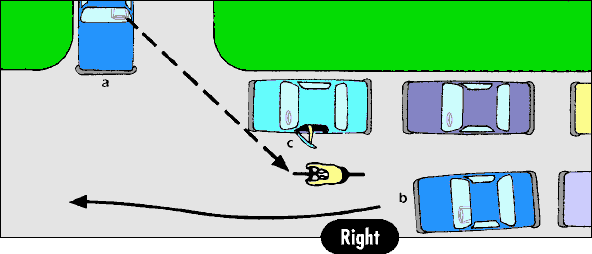A precedent-setting settlement for a cyclist run over after being doored should send a message to motorists, both exiting their parked vehicle and when driving, and cyclists when riding adjacent to parked cars.

"In a decision that local advocates say delivers a “strong message” to drivers, a Philadelphia jury awarded a cyclist $2.4 million in damages earlier this month for injuries she sustained in a 2011 collision," writes Streetsblog USA's Angie Schmitt.
Randy LoBasso of Philly Now provides the details: "On February 23, then-24 year-old Temple student Ashley McKean was traveling southbound on Broad Street [which turns out to be one of "the top spots for crashes in the city according to Bike Coalition of Greater Philadelphia] — when a parked car’s door “flung open,” according to court documents."
The door hit McKean’s leg. Then, a van came up and crashed into her from behind, sending her seven-to-ten feet through the air, landing on the pavement. She was subsequently run over by the van.
Dan McQuade of Philly Mag describes the verdict. There is a message here to bicyclists that should not be overlooked:
A jury found Marci Shepard (the driver whose door hit McKean), Robert Crawford (the driver of the van) and MCT Transportation (the van’s owner) at fault for the accident. It ruled Shepard 43 percent at fault, Crawford and MCT 36 percent at fault and McKean herself 21 percent at fault.
Yes - while the fault of the crash lies with the motorist who opened her door on the cyclist, cyclists too bear some responsibility to prevent being doored in the first place, though the article doesn't elaborate.
The best way to prevent being doored is to bike three feet away from parked cars according to Bicycling Street Smarts, as their two diagrams below from Chapter 2: Where to Ride on the Road illustrate:

|
"By riding a safe distance from roadside hazards, you increase your safety. When you ride correctly, the motorist in the driveway (a) sees you; the motorist overtaking you (b) will not take the easy way out and skim by your elbow; and the car door (c) is no threat." |

"Where there are parked cars, the usable width of the street begins about 3 feet out from them - or from a wall, hedge or other obstruction."
Transportation planners: Not all cyclists will follow the three foot clearance rule. Street design and bicycle infrastructure can improve bike safety. Sharrows are helpful where bike lanes, particularly buffered or protected, are impractical.
Of course, it goes without saying that motorists must know their responsibilities. In California, V C Section 22517, Opening and Closing Doors, states:
No person shall open the door of a vehicle on the side available to moving traffic unless it is reasonably safe to do so and can be done without interfering with the movement of such traffic, nor shall any person leave a door open upon the side of a vehicle available to moving traffic for a period of time longer than necessary to load or unload passengers. [Amended Ch. 162, Stats. 1963. Effective September 20, 1963.]
FULL STORY: Jury Awards “Precedent-Setting” $2.4 Million to Doored Cyclist

Planetizen Federal Action Tracker
A weekly monitor of how Trump’s orders and actions are impacting planners and planning in America.

Chicago’s Ghost Rails
Just beneath the surface of the modern city lie the remnants of its expansive early 20th-century streetcar system.

Amtrak Cutting Jobs, Funding to High-Speed Rail
The agency plans to cut 10 percent of its workforce and has confirmed it will not fund new high-speed rail projects.

Ohio Forces Data Centers to Prepay for Power
Utilities are calling on states to hold data center operators responsible for new energy demands to prevent leaving consumers on the hook for their bills.

MARTA CEO Steps Down Amid Citizenship Concerns
MARTA’s board announced Thursday that its chief, who is from Canada, is resigning due to questions about his immigration status.

Silicon Valley ‘Bike Superhighway’ Awarded $14M State Grant
A Caltrans grant brings the 10-mile Central Bikeway project connecting Santa Clara and East San Jose closer to fruition.
Urban Design for Planners 1: Software Tools
This six-course series explores essential urban design concepts using open source software and equips planners with the tools they need to participate fully in the urban design process.
Planning for Universal Design
Learn the tools for implementing Universal Design in planning regulations.
Caltrans
City of Fort Worth
Mpact (founded as Rail~Volution)
City of Camden Redevelopment Agency
City of Astoria
City of Portland
City of Laramie



























